Introduction It’s the beginning of a new year
Introduction
It’s the beginning of a new year. It’s too early to speculate what the year will has in store concerning conservation. We began with heavy down pour early in the month compensating for little rains experienced in October through December period. This has made the prairies look fantastically green and the hills are covered with heavy bushes which are flowering brilliantly. Animals are wandering freely within the vast ecosystem as they catch up with eating in an attempt to recover from the debilitating drought which had grave outcomes.
As the month came to a close animals have begun to intermingle closely with humans setting the beginning of trouble. As they intermingle both animals and humans suffer equally as events are not always favorable. Human-wildlife conflicts signs have been noted. Spearing has just begun originating from crop raiding and security threat during cattle herding.
Reach out programs and efforts are in top gear to reverse the animosity witnessed so far. This is encompassing all stakeholders on a government, non-governmental organizations and community level. Positive results have been experienced through the initiative so far. Hopefully harmonious relationship will be established henceforth.
Following are veterinary activities attended to during the month
CASE #1 ELEPHANT TREATMENT
Date: 4/1/2018
Species: Elephant
Sex: Male
Age: Juvenile
Location: Amboseli National Park
History
The injured elephant was spotted on 24/12/2017 by Senior Warden Amboseli National Park while on his game drive near the Ol-tukai swamp circuit. Due to poor network coverage and late hour in the day, he shelved the report to the following day when he shared the report with the Mobile Vet Unit. He had taken a photo and immediately in the morning hours we set out to look for the injured juvenile who was in the company of a large family herd last time he was spotted.
Extensive search was mounted within the swamps in the whole of Amboseli National Park. The two security teams of the park joined the search but all was in vain. On 3/1/2018 a tour driver while doing his morning ride spotted an injured elephant and immediately informed the Park Tourism Warden. The warden quickly sent out the Park Security team to go and verify and report back to him. Meanwhile the warden alerted the vet team to be on standby. In thirty minutes the case was confirmed and needed vet intervention.
The juvenile male was found at the edge of the swamp in the company of two big females one of which was the mother. The security team who had been sent to confirm the case kept close watch. We waited patiently after assessing the injury because it needed treatment. We confirmed it was the same one which had been spotted by the Park Senior Warden on 24/12/2017. They browsed towards the outside of the swamp and the juvenile crossed the road heading to the dry side of the park. As we prepared the dart the other female crossed the road to join the other two. The juvenile seemed unsettled because of fly’s on the wound bothering him. It was grasping long dry grass with its trunk and using it as a fly whip. The open wound discharging pus was on the right side of the chest, mid-way about one foot from the spinous process of scapular. It was an open septic wound and appeared to have been caused by a spear tentatively more than three weeks earlier.
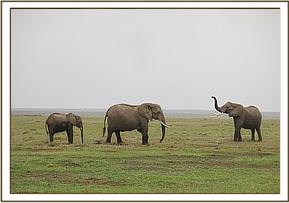

Immobilization, examination and treatment
The dart was made from 4.5mgs Etorphine in three centiliter dart topped up with water for injection. The security vehicle was strategically placed on the road between the elephants and the swamp to prevent them from invading the swamp during the immobilization process. The Vet vehicle was used to approach the elephant who was about five meters away from one of the females. The dart was to be propelled by Dan Inject dart Gun and the juvenile quickly went back to the female as it tried to seek security. While near the female a successful dart was placed on the animal sending panic to both the female and the juvenile. The juvenile ran away to the other female which was ten meters away. This is the time we realized that the female far away was the mother. The mother trumpeted ones signaling impending danger but we quickly withdrew and joined the security vehicle to aid in pushing the three elephants away from water body. They kept being anxious and after eleven minutes post darting the juvenile went down on his sternum, but shortly got up again. He moved a little bit but eventually gave up completely and went down on sternum. We rushed in to secure the juvenile from being injured by the females in an attempt to get it up. I had alerted the security team of resistance by the females to leave immobilized juvenile and possibilities of using blank shots to scare them away. This is exactly what happened. We chased them away with vehicle hooting and shots were fired in the air to a safe distance. We secured the wounded elephant by pushing it to the left recumbence exposing the wounded right side. The trunk was straightened and a piece of stick placed at the open end across to maintain patency. The right ear was used as blind fold and water was poured on the ears to keep the animal cool.


The wound canal was pronged for any foreign body by use of long forceps. There was no foreign body but the canal was leading ventrocaudally under the skin. The dead tissue hanging at the entrance was cleared and wound thoroughly cleaned with Hydrogen Peroxide and Iodine. All debris and pus were disposed of. The wound was then covered with wet green clay packed generously and topically sprayed with Tetracycline wound spray. The elephant was injected intramuscularly with 20000mgs Tetracycline and 50ml Multivitamin and 2000mg Flunixin Meglumine at different sites. 5grams of Cloxacillin ointment was used to infiltrate into dart wound and into eyes to prevent abscess and damage respectively.
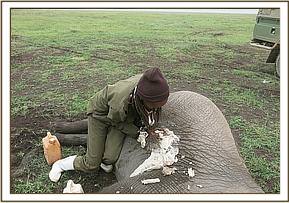

Reversal
This was done after seven minutes post recumbence with 40mgs Naltrexone into superficial ear vein. The elephant was up in two minutes. The mother was about four hundred meters away facing where the treatment was going on. The juvenile wandered for half a minute going round trying to pick up their scent and immediately started following the mother. The mother noticed its approach and begun to move towards it and after a minute they rejoined and were left together.
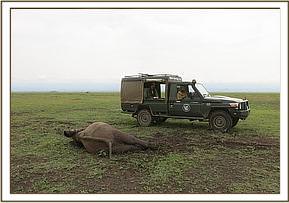

Prognosis
Prognosis is good because the animal was still strong and the spear had not gone into abdominal cavity.
CASE #2 INJURED ELEPHANTS
Date: 4-6/1/2018
Species: Elephant
Sex: Male, Female, Calf
Age: 2 adults, 1 calf
Location: Sagala Area; Voi
History
Three elephants were reported to have invaded a community area of Sagala hill near Voi town posing a security risk to the community. Efforts to drive them away using KWS security ground team, PAC team and DSWT were futile. The exercise almost turned tragic on 3/1/2018 when a security ranger was trampled. This led to gun shots aimed at scaring the animals away but it was said possibly the elephant was injured in fracas. This is what prompted the calling in of the vet team so that on 5/1/2018 a search would be mounted and if treatment was required, for the vet to be close by.
The vet unit travelled to voi on 4/1/2017 and on the following day aerial and ground team searches were mounted. We did not find any injured elephants but it was suspected they had joined a large group in Sagala Ranch the previous night after rangers drove them out. The search extended the following day on the 6/1/2018. It was during the mid-morning that the Unit was diverted to Kimana Sanctuary for a speared elephant after chances for locating the Voi ones slimmed. The Kimana Elephant had been spotted on 5/1/2017 with a spear lodged in its back. The Vet Unit embarked on Kimana intervention meanwhile being on standby for the Voi elephants.
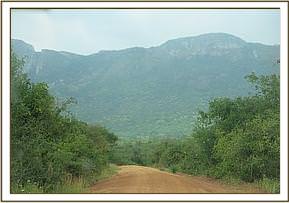

CASE #3 ELEPHANT TREATMENT
Date: 6/1/2018
Species: Elephant
Sex: Male
Age: Sub adult
Location: Kimana Sanctuary
History
The residential rangers of the sanctuary on 5/1/2018 came across an elephant during normal morning patrol which has a lodged spear on the left lumbar region. They immediately reached out to the Vet Mobile Unit. The Vet Unit informed the rangers that it had gone out the previous day to Voi to treat two injured elephant which had been reported on 3/1/2017. The Voi cases had not been treated because they had not been sighted yet though we kept within as search was intensified. Meanwhile the sanctuary rangers were told to keep a watch in case the opportunity arose and need to visit the Sanctuary beckon. The day ended without spotting the Voi ones. The following day the Unit was kept on alert as search for the both Voi and Sanctuary candidates went on. By mid-morning it was decided to make a quick rush by the Vet Unit to Sanctuary because chances of locating the candidate were much higher than the Voi ones. Big Life Foundation two vehicles and aerial fixed wing teamed up with the resident rangers and in mid-afternoon the vet unit was informed that the candidate had been located. By this time the Vet Unit was about ten kilometers away from Sanctuary. Spirits were high after receiving the news and we were directed to where the elephant was.
The sub adult male was alone under the thickets browsing. This time the spear had dislodged leaving blood oozing injury. This is what aided identification of the candidate. We approached on foot to observe the size and demeanor so that we could judge the amount of drug to use. One ranger scout led the way. After observation and positively identifying the candidate we retreated to make the dart.


Immobilization, examination and treatment
Dart composed of 7mgs Etorphine in 1.5cc dart topped up with water for injection. The two vehicles were placed strategically to help sight the animal after darting and where possible prevent it from going into the thicket nearby. The Vet vehicle was used for darting. It was approached quietly and found browsing. Before it could suspect what was about to happen the dart was propelled by Dan Inject gun and landed on the left rump. The animal panicked a little and took a fright, running about ten meters before settling under an acacia tree for four minutes post darting. It started walking into open ground and fell on left lateral recumbence in one minute. We quickly went in to secure and stabilize the candidate. The right ear was used as blind fold while the open rostral end of straightened trunk was kept open by sticking a piece of stick across. Liberally the candidate was dowsed with water to keep it cool during the treatment exercise.


Comprehensive quick treatment regime was sought after. The wound canal probed using forceps and there was no foreign body lodged. It was thoroughly cleaned using Hydrogen Peroxide and Tincture of Iodine. It had not gone deep into abdominal cavity. It was packed with wet green clay abundantly and then sprayed with Tetracycline wound spray. It was systemically injected with 15000mgs Amoxicillin, 50ml Multivitamin, 100mgs Flunixin Meglumine into different muscle sites. 5 grams of Cloxacillin antibacterial ointment was used to infiltrate into dart wound and into eyes.

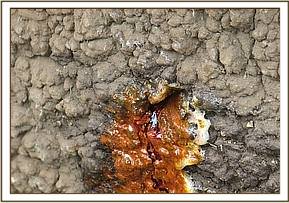
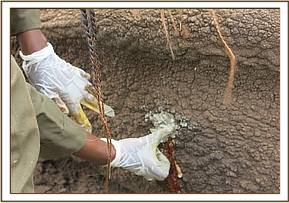

Reversal
Reversal was done after six minutes post recumbence with 40mgs Naltrexone into ear vein. The elephant was up in three minutes. It was turned by use of vehicles and driven into the nearby bush.


Prognosis
Fair prognosis was awarded because we believed there to be no internal injuries/bleeding.
CASE #4 ELEPHANT TREATMENT
Date: 10/1/2018
Species: Elephant
Sex: Female
Age: Adult
Location: Amboseli National Park
History
The lame wounded adult elephant was spotted on 9/1/2018 by a tour guide early in the morning as they went to ODARE swamp. The elephant herd was arriving in the park after a long time out of the park as they went looking for browse in the nearby community conservancies. A report was made to the park ticketing team which was inspecting tickets nearby. Immediately they informed the vet and we quickly rushed there. By the time we arrived we could not intervene because they were far much inside the swamp. We returned disappointed knowing that we had lost the chance and that the animal was still suffering. Fortunately the following day while Amboseli Elephant Trust team was on their routine monitoring patrol, they came across the elephant and immediately called the vet. This time they were within a dry area and there was a chance of successful treatment. We organized ourselves and wasted no time so that we could intercept them before they went into the swamp. We met the ATE team there and instituted intervention immediately.
The female was in the company of other nine other family members. The right fore limb was swollen especially from the elbow down. At the metacarpal joint laterally on the same limb there was pus discharging from a wound which appeared to have been caused by spear. It was about two weeks old as there was thick tenacious creamy pus coming out. They were browsing near a stream from the swamp and were allowed to quench and bath. Meanwhile we retreated at safe distance to make the dart without causing undue stress.


Immobilization, examination and treatment
14mgs Etorphine was used to make a 3cc dart which was topped up with water for injection. We approached the elephant quietly using a vehicle and the dart was placed rostral to left knee fold. Initially it appeared like a poorly placed dart even though it discharged immediately but the animal succumbed 6 minutes post darting. By this time it had separated from the rest of the family members but kept company of two calves by herself. They were driven away from the mother after two minutes when she fell on left lateral recumbence; we fired two blank shots into the air to scare them off. Quickly the elephant was stabilized by making sure the trunk was straight and maintained patent by use of a piece of stick placed at the rostral opening. The right ear was flipped forward to act as blind fold on the right eye. The prevailing weather was cloudy thus no water was used to dowse the animal and she had just drunk and had a mud bath in the nearby swamp.
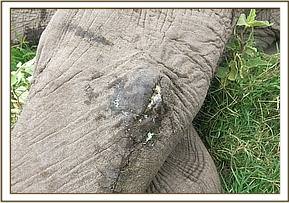

The wound was probed using long forceps for any foreign material/body but there was nothing. It was disinfected using Hydrogen Peroxide and Iodine. The debris was thoroughly removed and edges were freshened to initiate granulation and scab formation. 5grams of Cloxacillin Ointment was infiltrated as deep as possible into wound canal followed by generous packing of wet green clay. It was injected into different muscle sites with 20000mgs Tetracycline Hydrochloride, 50ml Catosal and 2500mgs Flunixin Meglumine. Dart was never retrieved as the animal was not flipped because the vehicle got stuck some fifteen meters behind the animal. It was to fall off on its own as it rubs against the tall thick solanium outgrowth.
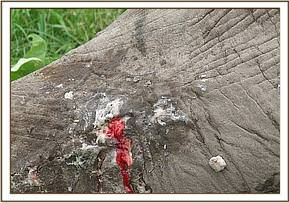

Reversal
Immobilization was reversed using 40mgs Naltrexone injected into superficial vein on the right ear. It got up after several attempts because the limb could not bend at metacarpal joint. It examined us carefully shaking its head but later it walked away limping.
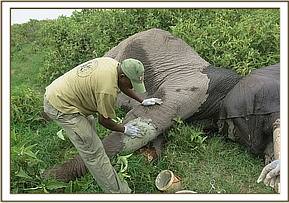

Prognosis
There was favorable prognosis. The joint integrity had not been interfered with and that it could reach out for browse and water.
CASE #5 OSTRICH CAPTURE
Date: 11/1/2018
Species: Ostrich
Sex: Female
Age: Adult
Location: Amboseli National Park
History
Ostrich is one of the bird species hardly treated because it rarely gets any ailment requiring vet intervention. This fact has led it to be almost forgotten species encountered in our day to day interventions thus we are not practiced in handling this animal. This is what informed the vet to do a demonstration to the Vet Unit personnel on how to go about it just in case it is encountered with a condition needing its capture. A demonstration was planned to take place in Amboseli National Park after enquiring from the Unit personnel who confessed that they have never handled the bird. The illustration served a big purpose in demonstrating capture technique to the Vet Doctor on her tenth month of annual internship.
Exercise Briefs
A brief on impending exercise was carried out in the open savannah of the Park to the personnel who were to be involved. This was in front of an ostrich couple with two big chicks about a hundred meters away. This was to be a good subject to test the skills of the internship vet because it is not an easy candidate to dart. Pros and cons of the exercise was meticulously instilled accompanied by demonstration on one of the personnel who acted as specimen. How to approach safely avoiding the front kicks of limbs and risks of being ploughed by the single claw on each limb was explained. That no need to approach from front, that head must be held high to facilitate open air way, that it is held by two handlers one on each wing origin and must keep very close to the birds body not to dislocate it, that wings ought to be picked and held firmly and simultaneously. The other point to be held in manual restrain is the base of tail by another handler. The purpose of chemical darting was to facilitate the handlers to be near the bird to effect manual restrain because as soon as that is achieved the bird sedation is completely reversed in order not to compromise on its health. Thus any intervention on the bird needed to be performed quickly before the bird is fully awake and fully recovered to resist manual restraint. This is presumed to be up to five minutes post reversal. Dangers of running into objects post darting in induction stage were explained. Risks of rolling upon recumbence and breaking its’ neck was also pointed out. Roles were divided amongst us and it was time to do a trial.


Immobilization
The intern vet was the one responsible for making dart, darting, effecting any needed treatment sampling and reversing the animal. A 1.5cc dart was made constituting of 4mgs Etorphine and 3mgs Medetomidine. It was filled to the top using water for injection. Before darting adventure, the Vet prepared any pocketed every piece of item which would be required. This included pre-drawn revivers both Naltrexone 40mgs and 5mgs Atipamezole in two different 2.5cc syringes capped with gauge twenty three needles, sampling blood tubes both EDTA and Plain, surgical blades, tick and fecal containers and necessary needles and syringes. Vehicle was used to approach and dart. The female separated herself in a manner like leading us away from the rest of flock for their safety. The male remained with the two chicks. She pretended to cover the chicks and after every ten to twenty meters ran waiting for the vehicle to get closer. This behavior proved useful in the darting exercise as it turned out that she was near the vehicle close enough for a successful quick accurate dart on the thigh which she kept exposing. This solved the darting misery. After two runs, it was darted on the third bout of running when she waited the vehicle while on sternal recumbence. Dart was quickly placed on the upper thigh and dispensed completely. We immediately stopped in order to avoid unnecessary stress but maintained her on visual because it was on open savannah. She started depicting narcosis signs after five minutes post darting by reversing and running forward aimless wobbling from side to side. An approach on foot was tried but she took off. We allowed two more minutes and she began rolling on dusty plains. Two handlers simultaneously approached and held firmly the wings while she was on left lateral recumbence and placed her on sternal recumbence with head held up by one hand of the handler. Neck was too weak to hold the head on its own.
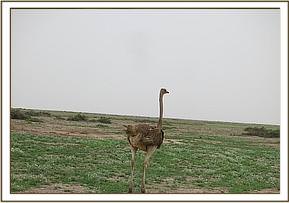

Reversal
The vet immediately injected the revivers into the left thigh muscles immediately. The vet went on with sample taking and the animal recovered fully after four minutes post reversal administration. It was hard maintaining the bird in sternal recumbence as she grew strong. Another handler was called in to hold the tail and this hardly subdued the bird which by now was opposing manual restraint. Because we had successfully attained the aim of demonstration, we released the bird in direction of the cock so that they could meet up.
Recommendation
It was noted that the chosen drug worked well as per expectation but then the bird regains energy quickly after reversal. This might limit the intervention time and bird proves difficult to handle. This thus calls for extra handlers. Approximately two handlers on each wing, two free attendants, a photo man and a tail handler. This manpower can resist the energy of the fully awake bird. Also always a suitable and specially light designed blindfold to be used without covering the mouth and little pressure on the laryngopharyngeal area so as not to compromise airway patency. The two free attendants would systematically and in a synchronized manner effect the necessary intervention before the bird is fully and energetically awake to cause panic.
Way Forward
Probably on different occasions, complete or partial reversal of each single or both drug/s to be done and effect recorded so that a protocol can be determined on nature of reversal initially followed by the final reversal of the other drug/s after completion of the intervention. Complete reversal of both drugs early before intervention could lead to shortage of intervention time because the bird recovers quickly from anesthesia. Otherwise the exercise was a success.
CASE #6 ELEPHANT IN GULLEY
Date: 14/1/2018
Species: Elephant
Sex: Male
Age: Sub-adult
Location: Marba; Amboseli National Park
History
A sub-adult male elephant was reported by Big Life Foundation Marba Team to have been found on the floor of a gully unable to stand. The vet team was on its way back from Nairobi to Amboseli where it had gone to pick classified drugs and other necessary supplies. The elephant’s family members were roaming within the area as if waiting for the little one to join them.
After thorough screening concerning the elephant it was obvious that the elephant had plunged approximately ten meters into the gulley with its posterior side first. It kept struggling to get up but posterior side depicted paralysis. Due to exigency of duty I could not make it that day and by fact that the case had poor prognosis I authorized the KWS PAC Team whom I had screened about the situation to euthanize the elephant and recover trophies for safe custody and onward transmission. This was to get rid of unnecessary suffering because it appeared it had injured its spine within lumbar area.
The team decided to give it chance to see whether it would recover overnight. In the morning the elephant was static with weak breath. It was at that point that it was euthanized and trophies recovered.


Acknowledgement
The role played by all stake holders cannot be under estimated. Profoundly the David Sheldrick Wildlife Trust sole sponsorship of the Vet Unit in order to achieve its mandate. Together with KWS Fraternity aid, all interventions were well and timely delivered. Acknowledged is the never ceasing support from conservation friends which include area Non-Governmental Organizations, private individuals and the community conservancies. The existing team work is commendable and hopefully the same will be experienced in future.








































